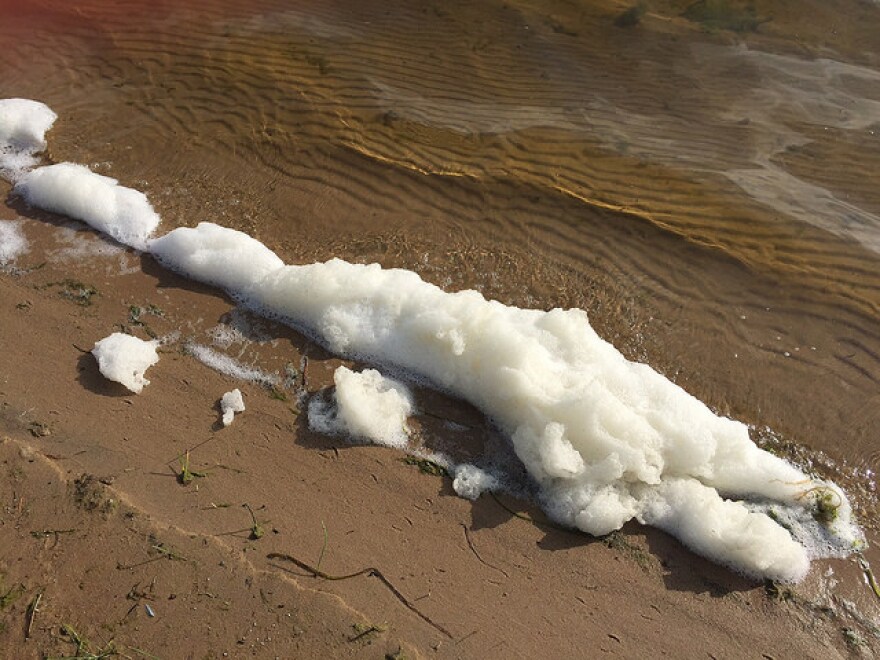Over the past two years, Michiganders across the state have become aware of the chemicals known as PFAS. They first made news when elevated levels were found in more than 20 private water wells in Oscoda. Now, there are 35 known contamination sites around the state.
The term PFAS refers specifically to “per- and polyfluoroalkyl substances,” (the term “PFCs,” or perfluorinated chemicals is also sometimes used).
There are more than 4,000 different chemicals in this family, including two common ones called “PFOA” and “PFOS.” PFAS chemicals are known for their durability – they are incredibly resistant to most elements, which is why they’ve been used in materials ranging from waterproof shoes to firefighting foam to non-stick pots and pans since the 1950s.
The quality that gives PFAS chemicals such a wide range of industrial uses is also what makes them a public health hazard. These chemicals are nearly impossible to break down, meaning that they persist in the environment.
According to the Environmental Protection Agency (EPA), some PFAS chemicals – including PFOA and PFOS – are no longer manufactured in the United States, but consumer goods containing these substances can still be imported. Several factories across Michigan have been cited as responsible for PFAS contamination in communities across the state, some of which haven’t used the substances in decades. That means that contamination likely began years ago but was only discovered by state officials when they recently began testing for it.
A recent national survey that examined large water systems found that systems with elevated levels of PFAS were linked to proximity to military fire training areas, wastewater treatment plants, and facilities that manufactured PFAS in the past. PFAS exposure typically results from contaminated drinking water as the chemicals cannot easily be absorbed through the skin.
Michigan Radio will be reporting onPFAS contamination across the state every day this week. Below, you'll find Stateside conversations that answer listener-submitted questions about the chemicals' impact in Michigan.
Check out a timeline of the state's response to PFAS contamination below.
How do we clean up this PFAS mess?
Tom Bruton is a scientist at the Green Science Policy Institute. He joined Stateside to discuss what makes PFAS chemicals so difficult to clean up.
The biggest problem is that PFAS chemicals do not break down naturally in the environment.
“Becuse PFAS are so persistent, a lot of the tools and tricks that engineers have for cleaning up water contamination don’t work for as well for PFAS,” Bruton said.
Bruton has researched one method that does work for PFAS remediation: in-situ chemical oxidation.
“It’s a little bit like adding bleach to your laundry. Bleach is an oxidant chemical. You add it to the laundry, it reacts with the stains in your clothes, the stains go away, the bleach doesn’t leave anything too nasty around. In-situ chemical oxidation is a similar process, where we introduce an oxidant underground, and hopefully detoxify the contaminants,” he explained.
Unfortunately, because PFAS compounds are so stable, the treatment is not entirely effective. This method also requires a large amount of chemicals to be pumped into the ground.
The most common way to treat PFAS-contaminated water is the “pump and treat method.” After water is pumped out of the ground, it is run through a PFAS-removing filter, then returned to the same spot. This, Bruton said, would be a costly and time-intensive solution. Addressing all the PFAS water contamination across Michigan would likely take decades and cost billions of dollars.
How do you get PFAS out of your water?
Rick Andrew is the Global Business Development Director of Water Systems at NSF International. He joined Stateside to discuss how NSF tests water filters that claim to treat for PFAS chemicals.
Manufacturers have created filters to treat PFOA and PFOS, two chemicals in the PFAS family. NSF, an independent global public health organization based in Ann Arbor, tests those filters to ensure they are, in fact, treating water for PFAS chemicals.
Andrew said the group’s main goal is to “make sure that the filter is treating those chemicals effectively when it is being used by people who are counting on it to provide clean, safe drinking water for their families."
In order to be approved, the filters need to limit the water’s chemical concentration to 70 parts per trillion, which is the safety threshold set by the U.S. Environmental Protection Agency. The testing protocols ensure that approved filters are removing at least 95 percent of PFOS and PFOA in drinking water.
Andrew said the tests are difficult to control because the level of PFAS they are testing for is so low, but he said NSF has designed specialized equipment to accurately measure levels of PFAS.
The group publishes a list of filters that have been tested to reduce PFAS chemicals to the approved level. Andrew said that many filters can treat for multiple contaminants, including PFAS and PFOS, but not all do. NSF has some tips for choosing a filter that best fits your needs.
Who will foot the bill for PFAS contamination?
Removing PFAS from the environment and from local water sources is projected to be a long, costly process. So, who’s going to pay for it?
Oday Salim, an attorney with the National Wildlife Federation, joined Stateside to answer that question.
Businesses that produce chemicals in the PFAS family eventually discharge them into their local sewer system, and send that water onto a sewage treatment plant. These plants are built to treat waste, and they aren’t typically equipped to remove chemicals like PFAS from the water supply. This means that contaminated water can pass straight through a plant untreated and end up in surrounding waterways.
Last month, the state of Michigan discovered PFAS at levels more than 450 times the federally-advised limit in Norton Creek in Oakland County. Officials traced the chemicals back to Tribar Manufacturing, an auto parts company based in Wixom.
According to Salim, in this case, both Tribar Manufacturing and the sewage treatment plant that processed its wastewater could potentially be held responsible for PFAS contamination.
“My questions are first of all, did the automotive supplier know that it was putting those PFAS chemicals into the sewage system? Did it have standards that applied to it in order to treat the chemicals before they got to the treatment plant? Did the treatment plant appropriately put limits in its industrial pre-treatment program laws to make sure that those PFAS chemicals never get to the sewage treatment plant and then ultimately into Norton Creek?” Salim explained.
For now, those questions have yet to be answered. Under the Clean Water Act, the state of Michigan and its residents have the right to file a lawsuit against whoever is considered responsible for the contamination. If either Tribar Manufacturing or the sewage treatment plant were to admit wrongdoing, they could also work voluntarily with state officials and people affected by PFAS to help solve the problem.
If no one is found legally liable for the PFAS contamination in Norton Creek, there’s a chance that taxpayers might end up footing the bill. For example, Salim says, if PFAS were to make its way into a public water supply, that system would have to be upgraded to filter out the chemicals. The cost of those upgrades would likely fall to taxpayers.
How does PFAS impact your health?
Courtney Carignan is an environmental exposure scientist and epidemiologist at Michigan State University. She joined Stateside’s Cynthia Canty to discuss the specific effects that PFAS exposure can have on human health.
“There are enough studies to say that exposure to PFAS is clearly linked to toxicity of the liver, the immune and endocrine systems, as well as the developing fetus and newborns. And this is why there is a health advisory for drinking water,” Carignan said.
Three factors play a major role in determining the effects that PFAS can have on a person’s health: timing, dose, and duration. Like many chemicals, pre-natal or early life exposure can have a different impact than exposure during adulthood. Those who are exposed to high levels of PFAS or who are regularly exposed to lower levels are at greater risk than those who have been only incidentally exposed to the chemicals.
Carignan says that scientists have been conducting research on PFAS for decades, but that some of those reports have only recently become public. The majority of studies focus on determining whether or not exposure to PFOA and PFOS is safe for humans.
She says Michigan residents who discover that their water has been contaminated with PFAS chemicals should find an alternative source.
“You can reduce your exposure [to water contaminated with PFAS] by following the guidelines of drinking water that doesn’t contain PFAS, so either by drinking bottled water or installing a water filtration system on your tap,” Carignan said.
Son of a state legislator who pushed for stricter PBB regulations now grapples with PFAS contamination in his own community
Attorney Tony Spaniola is no stranger to chemical contamination in Michigan. His father, former State Representative Francis Spaniola, was in office when the state responded to PBB contamination in the 1970s. Now, Spaniola is one of the many Oscoda residents who learned that his family cottage was in the “zone of concern” for PFAS contamination originating from the nearby Wurtsmith Air Force base.
Spaniola attended town meetings during which state health officials explained the situation to Oscoda homeowners. He says that those officials sounded like they wanted to be proactive in finding a solution to the contamination. “[But] once it became apparent that the problem was beyond Oscoda, that it was beyond the Air Force and the military, that it might impact businesses and industry throughout the state, it was like we hit a brick wall,” Spaniola said.
When it comes to both state and federal response to PFAS chemicals, Spaniola has yet to be impressed.
“In Oscoda, we’ve been at this for eight years now in the community there," Spaniola said. "They first discovered [PFAS] in 2010, and… today there’s no plan to address the plumes that are migrating from the former base into the Au Sable River [and] into Van Etten lake. Those two water bodies flow right into Lake Huron… [which] is a source of municipal drinking water for lots and lots of people. So, when I hear the Air Force and the Pentagon saying ‘We’re cooperating with local communities,’ in Oscoda, that’s just not the case."
Spaniola thinks Michigan needs to be more transparent with its citizens regarding the scope of PFAS contamination and what it means for human health.
“I think the first thing the state needs to do is to have an honest conversation with the citizens of our state, to let them know that this is a major and significant problem [and] that it impacts virtually every corner of the state,” Spaniola said.
This post was written by Stateside production assistants Isabella Isaacs-Thomas and Natalie Brennan.
This post was updated at 2:58 p.m. on Friday, October 5, 2018.
(Subscribe to the Stateside podcast oniTunes, Google Play, or with this RSS link)









